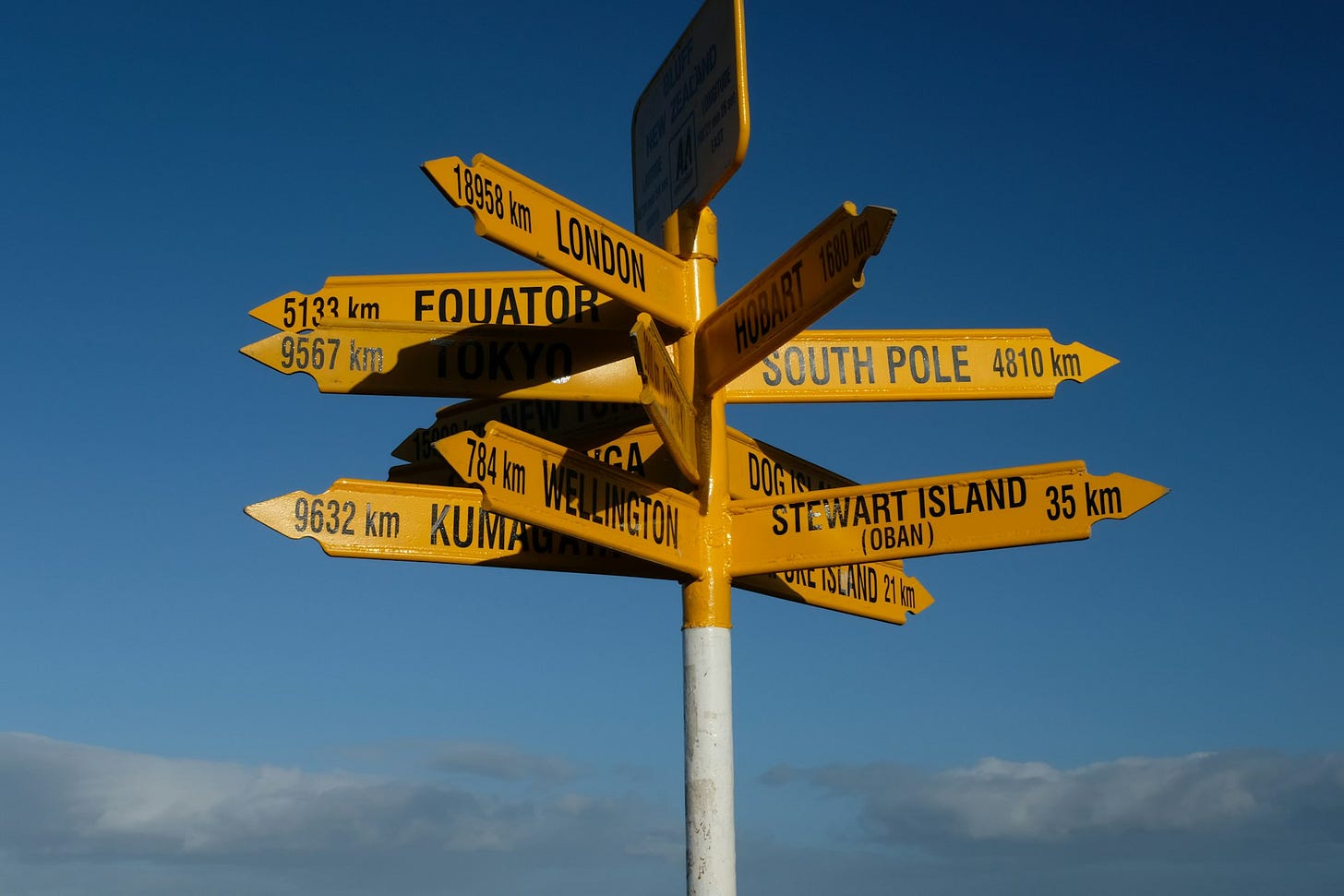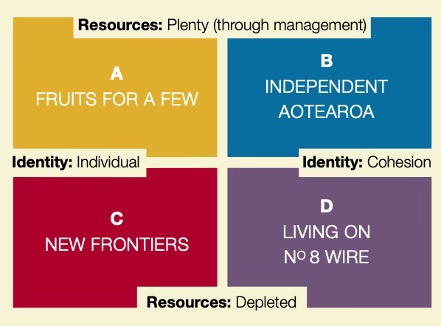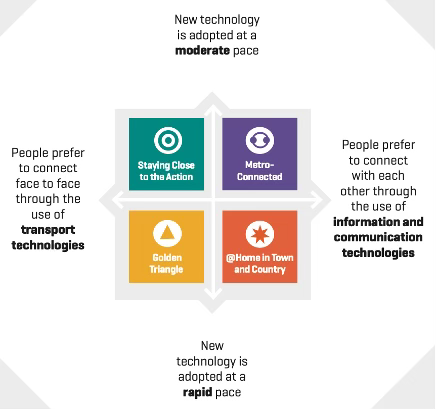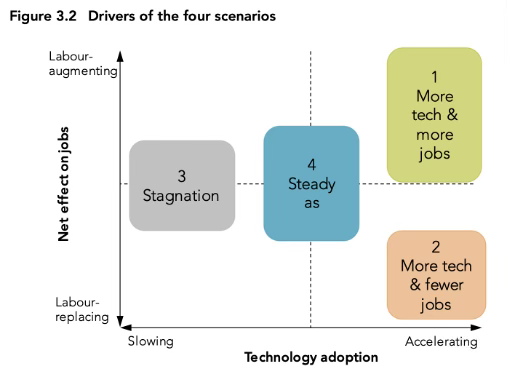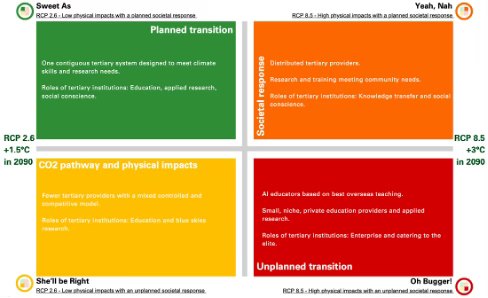Previous New Zealand-specific scenarios
Aotearoa has a modest collection of futures scenarios. This has picked up in the last 5 years, but scenarios for New Zealand need to be more ambitious and varied.
I’ve written previously about how New Zealand exhibits “futures inertia”, with poorly developed futures practices. That’s starting to change, but we still risk thinking too narrowly and too short term, with a tendency for going for quick rather than more insightful futures perspectives.
I’ve been looking at some of the New Zealand scenarios developed by various groups this century. The McGuinness Institute helpfully has a list of some of the publicly available ones (up to 2022), and I’ve identified a few more. There will be others, but possibly not readily discoverable. The NZ Defence Force, for example, has developed scenarios over the last few decades, but they don’t share them widely. Community groups are likely to have developed some too. Let me know of other interesting kiwi scenarios out there.
In the found scenarios there are basically two sorts. The first are quantitative projections. These are what The Treasury does and the Ministry for Business, Innovation & Employment. For example, the latest MBIE Energy Demand & Generation Scenarios mostly consider alternative economic growth rates, new technology adoption choices, and greenhouse gas emission targets. NIWA models NZ-specific climate change scenarios based on global projections.
The second are more qualitative. The most common type by far focuses on two key uncertainties to create (usually) four scenarios. This is the classic 2 X 2 (or double uncertainty) futures matrix popularised by the Global Business Network (now part of Deloitte). Despite a range of other scenario generation methods (discussed by Andrew Curry, and illustrated below) this approach is widely used because of the relative simplicity – you look at just two key issues.
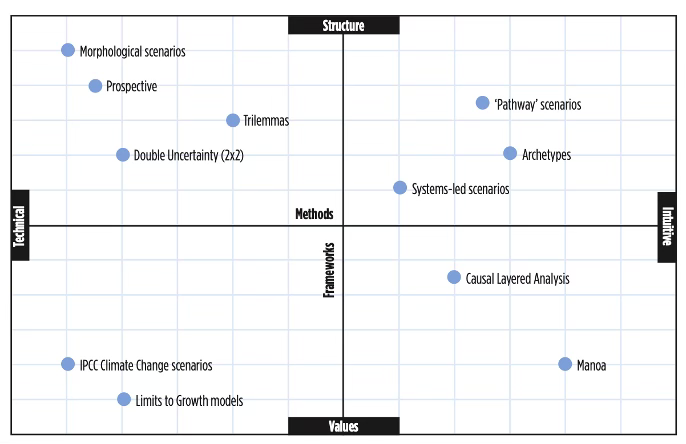
Aotearoa’s 2 X 2 Futures
In 2007 Landcare Research/ Manaaki Whenua developed four futures for NZ based on the abundance or availability of resources and whether our society acted more collectively or more selfishly. These futures were considered “a few decades” on from 2007.
As part of a research project investigating the future of the Waikato region four scenarios were created based on how “wealth” is assessed (purely profit vs social & cultural too) and how sustainably natural resources are used.
A 2012 Victoria University/Te Herenga Waka study considered the future of tourism in 2050. Like the Landcare scenarios this used the lenses of resource abundance and societal behaviour, but took a global perspective of them.
The Ministry of Transport/Te Manatū Waka, in a large project involving diverse stakeholders, developed four future demand transport scenarios based on the rate of new technology adoption and whether people prefer to connect in person or digitally. They also factored in economic and population growth rates, and how dispersed the population is. The scenarios were done in 2017 and looked out 25 years. They were used as a prompt for further discussion on transport policies.
In developing its report on technology change and the future of work the Productivity Commission/Te Kōmihana Whai Hua o Aotearoa created in 2019 four scenarios based around technology adoption and the number of jobs. Unlike the other matrix scenarios, the Commission didn’t use four symmetric quadrants. I wrote a critique of their scenarios.
Sport NZ/Ihi Aotearoa (2022) developed four alternative futures for Sport NZ based around the extent to which greenhouse gas emissions are reduced versus the degree of social cohesion. They also developed a preferred future for the sector. [Disclaimer: I am helping in some of Sport NZ’s futures work, but wasn’t involved in the scenario development]
A multi-institution study (2023) developed four scenarios to explore how climate change will affect tertiary education by 2100. The scenarios were based on the degree of warming and how planned were global societal responses to climate change.
Single factor scenarios
Some other scenarios have focused on a single driver. The Energy Efficiency & Conservation Authority considered the impacts of energy generation and usage (2021) depending on whether greenhouse gas emissions reduction was a national priority or whether reductions were left up to individual firms, sectors, and regions.
The Parliamentary Commissioner for the Environment also considered electricity and other energy demands(2005) and implications when a business as usual – big energy project thinking – was pursued, compared with re-thinking energy usage and support for smaller scale local projects.
Climate risks for future aquaculture and fisheries were considered through two scenarios developed by KPMG for the Aotearoa Circle (in 2020). The first was the impact when emissions were not effectively controlled, and the second when warming was held below 2OC.
The Our Land and Water National Science Challenge developed four scenarios about the future of alternative protein sources (plants and/or fermentation as replacements for meat and dairy products) and the land use, economic and environmental impacts for New Zealand. This was a modelling study, published in 2024.
The Aotearoa Circle developed three scenarios for tourism in 2050, based on the level of effectiveness of climate change policies and actions. Separately, a collection of essays on the future of tourism has also been published as 100% Pure Future by Bridget Williams Books.
Koi Tū: The Centre for Informed Futures imagined a future Auckland (2022) that is a global, liveable and sustainable city through 9 integrated scenarios.
As part of their Auckland Plan 2050 process Auckland Council developed 5 short scenarios, each based on a separate key idea (climate resilience, safety, transport, food bowl, or inequality).
While not strictly a scenario, Taranaki groups co-designed, in 2019, a regional vision and roadmap for 2050. This presented a desired social, economic and environmental future.
Other scenario methods
My 2015 Four short science scenarios used the four futures archetypes developed by Jim Dator. These focus on systems rather than uncertainties and get you to think about the consequences of systemic changes and constraints, rather than simplistic change. Most people like to jump to a “transformed” future no matter what scenario method is used. What I particularly like about the archetype set is that the “constraint” and “collapse” scenarios make you explore the opportunities as well as challenges in less idealised futures.
Insights from New Zealand’s scenarios
Fifteen or so scenarios seems a small number over the last 25 years. But I’m encouraged that half have been developed in the last five years, suggesting a growing use of scenarios.
I’m not a big fan of the 2 X 2 approach because I think it oversimplifies choices and what can or will shape the future. The method can lead to reductive rather than expansive thinking. There’s often a most desirable future, which can result in less consideration being given to how to avoid, adapt to, or influence the other options.
However, the method is an entrée into deeper thinking about the future, which should be encouraged. But there needs to be plenty of discussion and debate before the two key uncertainties are decided, and each scenario needs to be detailed, rather than superficial.
More important than the tool is to have a skilled practitioner involved, and a diversity of people, perspectives, and ideas contributing to their creation.
What’s also noticeable about the New Zealand scenarios is the high proportion that focus on social and environmental factors. Elsewhere technologies and geopolitical issues can often be a major focus of scenarios. Tourism, farming, and fisheries are topics of our scenarios. None are about becoming a “high tech” economy (except for some biotech). We seem to have used scenarios to “save” existing sectors, rather than explore new ones.
Yes, we have plenty of slogans, visions and shallow thinking about a future “high tech, high value” economy, but we lack good scenarios that explore what this could look like in more detail, and the systemic steps we need to get to such a state and the compromises that could be required.
Nor are Māori culture, world views, and aspirations strongly represented in the selection above. Many of the scenarios, or the reports they are in, over-indulge in images of fern fronds, but don’t seem to be shaped by a Māori world view. The Taranaki roadmap was, though, strongly influenced by Māori aspirations and values. Sport NZ’s futures work also includes a Māori lens in other futures reports. I expect there are scenarios from others based on te ao Māori but these are not as easy to find.
Lastly, nearly all of the scenarios are fairly predictable and earnest. I usually wasn’t surprised by them, and there weren’t any weird or seemingly wacky options. Most sit within plausible expectations. As I’ve written previously, raising some “unthinkable” or “unpalatable” events or futures is an important function for futures work.
In my science scenarios I did introduce some whimsy, but more is needed. This is not only to make them more engaging, but to help challenge traditional ways of perceiving and thinking.
Exploring more of the scenarios landscape
I’d like to see future scenarios for Aotearoa be more adventurous and expansive - trying different methods, and examining more unpalatable as well as novel futures. We should also explore more of the constraints and compromises that we will undoubtedly face.




